Golden Fort Jaisalmer [Sonar Quila]
At a distance of 1.5 km from Jaisalmer Railway Station, Jaisalmer Fort locally known as Sonar Quila (Golden Fort) is located in the heart of Jaisalmer city. It is one of the largest forts in the world and also one of the top places to visit in Jaisalmer. Jaisalmer Fort. is a World Heritage Site declared by UNESCO under the group Hill Forts of Rajasthan.
Jaisalmer Fort was built atop the Trikuta Hill in 1156 AD by the Bhati Rajput ruler Maharawal Jaisal Singh, from where it originates its name. It was the center of a number of historical encounters between the Bhattis, Mughals, and Rathores of Jodhpur. The Fort of Jaisalmer survived several attacks by the Muslim rulers like Aladdin Khilji and Mughal Emperor Humayun. The city also served as a refuge and way-station for caravans and travelers along the Silk Road.
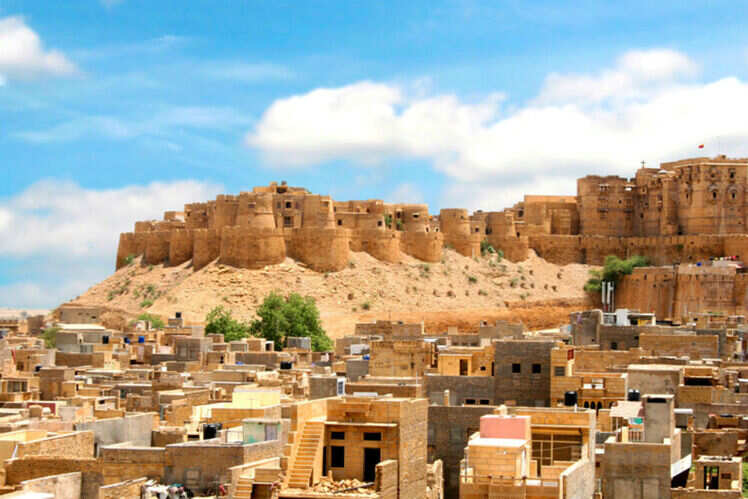
Standing proudly in the middle of the great Thar Desert, this fort is regarded as 'The Pride of Jaisalmer'. Its massive yellow sandstone walls are a tawny lion color during the day, fading to honey-gold as the sun sets, thereby hiding the fort in the yellow desert. For this reason, it is also known as the Sonar Quila or Golden Fort.
The Jaisalmer Fort architecture is awe inspiring and marvelous. The seamless blend of Rajput and Islamic styles, the golden tinge due to the yellow sandstone, and the enthralling carvings & sculptures make it rank among the glorious forts in Rajasthan. It is 1,500 ft long and 750 ft wide and is built on a 250 ft high hill. The basement of the fort has a 15 ft tall wall forming a double line of defense. The fort is protected by a 30 ft tall wall surrounding it on all sides. This fort comprises of 99 bastions providing crucial protection to the fort during attacks.
Inside the fort complex, tourists can find several architectural buildings which include palaces, houses and temples. Jaisalmer fort has narrow winding pathways which interlock several parts of the fort. The complex of Jaisalmer fort is so expansive that almost one-quarter of the town's population located inside the fort itself. There are numerous wells inside the fort that are a regular source of water for residents.
:max_bytes(150000):strip_icc()/GettyImages-533638374-5b9ced74c9e77c0050b73539.jpg)
The fort has four entrances namely Ganesh Pol, Rang Pol, Bhoota Pol and Hawa Pol. The main attraction of the fort is Maharawal Palace popular for its marble throne. The Palace also has a wonderful museum which showcasing arms, dresses, utensils, & ornaments of the Rajput kingdom. An added attraction of this place is a five-storied Tazia tower located parallel to the Maharawal Palace. This tower was constructed by Muslim craftsmen and is made with decorative Bengali styled roofs. Jain Temple and Lakshmi Temple are also quite famous among the visitors.
Palace Timings: 9 AM to 6 PM
Palace Entry Fee: Rs. 50 for Indians, Rs. 250 for Foreigners, Rs. 50 for Camera
Patwon ki Haveli Jaisalmer :- At a distance of 500 m from Jaisalmer Fort and 1.5 km from Jaisalmer Railway Station, Patwon-ki-Haveli is situated in a narrow lane near the Patwa Complex in Jaisalmer. It is the first haveli to have been erected in Jaisalmer and also one of the top places to visit in Jasalmer.
The Patwon ki Haveli is considered to be the one of the largest as well as the finest haveli of Rajasthan. This haveli is essentially a cluster of five havelis, which was constructed in 1805 CE by Guman Chand Patwa. A rich trader, Guman Chand Patwa constructed five separate sections for his five sons. The first haveli is the main and also the grandest haveli in the complex. The entire construction took over 55 years to complete.

Located in the center of the city, it is truly an outstanding piece of architecture. It is renowned for its ornate wall paintings, intricate yellow sandstone-carved jharokas or balconies, gateways and doorways. The haveli is built using yellow sandstone and the main gateway is brown in colour. The haveli is five stories high divided into six apartments. The walls also feature beautiful mirror work and several paintings. There is a stunning apartment which is flawlessly painted with beautiful murals. There are about 60 balconies in the haveli.
Amongst the five Havelis which form the entire complex, one has been converted into a museum which displays a vast collection of antique furniture and decorative goods. Besides this, the third Haveli or mansion in the premises also houses rich items that include traditional art and craft work of the local craftsmen. Two havelis are under the authorization of the Archaeological Survey of India and one serves as private accommodation.
Currently, this haveli is maintained by the state government, which uses it for different official purposes. The office of State art and craft department and the Archeological Survey of India (ASI) is placed in the haveli.
Timings: 8 AM to 6 PM
Entry Fee: Rs. 20 for Indians, Rs. 100 for Foreigners and Rs. 50 for Camera
Jaisalmer War Museum :- At a distance of 11 km from Jaisalmer Railway Station and 12 km from Jaisalmer Fort, Jaisalmer War Museum is situated at Military Station on the Jaisalmer - Jodhpur Highway. This unique war museum is surely a must visit place for all Indian and foreigner tourists coming to Jaisalmer.
Jaisalmer War Museum was set up by the Indian Army in 2015 and was inaugurated on 24th August by Lieutenant General Ashok Singh, General Officer Commanding in Chief, Southern Command. The inauguration of the Museum in the Golden Jubilee Commemoration Year of 1965 Indo Pak War is also a tribute to all soldiers who made the supreme sacrifice.
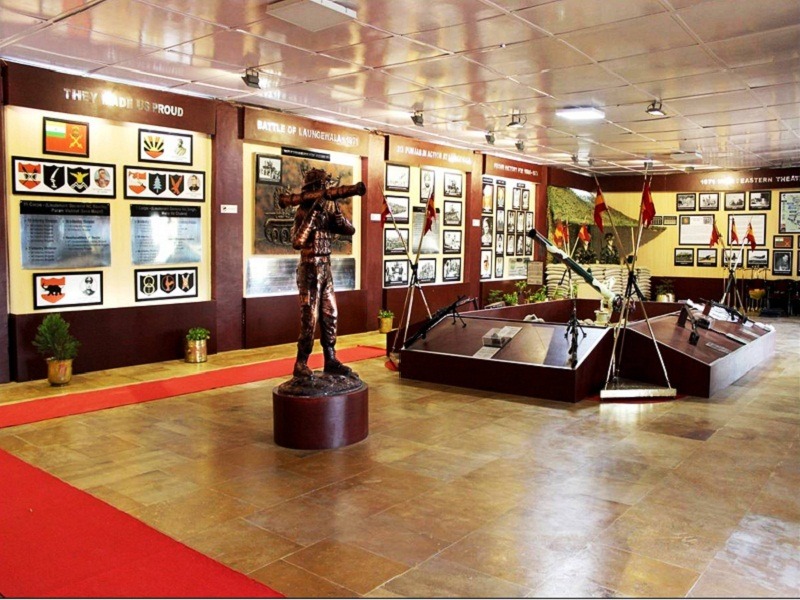
The museum covers an area of over 10 acres of land. It has two large Information Display Halls, an Audio Visual Room and a souvenir shop. Apart from the evolution of the Indian Army, the museum showcases tales of bravery and sacrifice of heroes of the wars. War trophies and vintage equipment are on display along with tanks, guns and military vehicles. The museum has murals of soldiers who lost their lives in the war and weapons used at that time. The Indian Air Force has also contributed in the museum by presenting a hunter aircraft, which was used during the Battle for Longewala during the 1971 Indo Pak War.
The Museum is organized by the Indian Army. The entry to the Jaisalmer War Museum is open to and free for all visitors.
Timings: 10 AM to 6 PM
Tanot Mata Temple Jaisalmer :- The Tanot Mata Temple situated in the Tanot village of district Jaisalmer, is a major attraction for those visiting the Thar Desert in Rajasthan. It is enveloped within numerous legends that are sure to instil awe and curiosity towards its sacred power and purity. The heritage site is preserved and maintained by the Border Security Force (BSF) of India since the Indo-Pakistan war in 1971.
Localities have immense faith on the temple’s austerity and pay regular visit to the Tanot Mata. She is believed to be an apparition of the Hinglaj Mata Goddess. Tanot is in close proximity with Longewala, a critical India-Pakistan border that forbids access to any individual without permission of Indian Government authorities. Due to its topography, it can harness large quantities of wind energy, thus visitors can see the rows of windmill energy power plants established here. There is a museum built adjacent to the temple that displays certain historic artefacts collected from the war period. This is a must visit place for those who wish to pay their homage to the Indian Army and the temple that is considered holy by the Indian heroes of defence and harmony.

History :- It is said that during the Indo-Pakistani War of 1965, Pakistani Army dropped over 3000 bombs targeting the temple but not even one exploded! The Pakistani Tank regiment was stupefied and kept shelling but not one bomb exploded. After the war the Pakistani General actually asked his counterpart in India about this incident and on knowing the story of the power of the temple that apparently protected the area he asked to see this place. This request was granted and the Pakistani General actually went to the temple and paid his respects and acknowledged the supernatural happening. After the war the temple management was handed over to Border Security Force of India on their request and to date the temple is maintained and manned by the BSF soldiers.
After paying your respects to the Goddess, you can take a round of the museum established in the same vicinity. It holds a public exhibition of the arms and ammunitions used during the Indo-Pakistan wars of 1965 and 1971. They hold great significance, as the bombs used to attack the natives of Tanot village never diffused. The place is one of the best place to explore in the Thar Desert in Rajasthan. This temple was shown in the film Border. The best time to visit is November – January, when the temperature is not likely to be extremely high. Taxis can be hired from Jaisalmer After completing this pilgrimage trip, you can plan a camel safari in the Thar Desert or plan a sightseeing trip of the majestic forts of Jaisalmer.
Longewala Border :- Longewala is a border town in Thar desert near Jaisalmer, Rajasthan. The army of Lt. Kuldip Singh was commanding this small post because on the other side Pakistani forces were awaiting an opportunity to attack and takeover Jaisalmer. At the night of 4th December 1971, the Indian army observed noises across the border that suggested a heavy platoon approach. As it was dark, the moon was the only source of light that lit the scene.

The Battle - When sources confirmed that Pakistan indeed was approaching, Lt. Kuldeep Singh contacted the headquarters and asked for reinforcements. He was informed that it would take six hours for backup to be available and was advised to retreat to a nearby town, Ramgarh. But Kuldeep Singh and his men held ground fearlessly and decided to fight. After midnight Pakistan surfaced near Longewala and opened fire with artillery guns. As the 45 heavily equipped tanks of Pakistan
approached the border, Indian defences laid a hasty anti-tank minefield. Indians were at the advantage of holding the higher ground; Pakistani tanks struggled to move upward and blasted themselves in doing so. This gave an opportunity to Indian soldiers to spot and attack the enemy, a fire lit the otherwise dark battlefield. Indian defence used a smoke screen to confuse the Pakistani soldiers and stalled the battle till reinforcements arrived.

Who won the battle?
India, though outnumbered, applied clever strategies to maneuver its way through the fight. After a long battle, Indian Air force was able to send backup in the morning. Now, the opposition’s battalion was an easy target as they were on the ground and didn’t have an Airforce to help them out. After getting 22 tanks blasted with rockets, Pakistani army was forced to withdraw.
Aftermath of the battle - 120 soldiers against 2000, sounds daunting. But what’s surprising is that India only lost 2 soldiers and 1 tank while Pakistan lost 200 soldiers and 36 tanks, in the battle. Kuldeep Singh was applauded for his strategic win and was conferred with the Mahavir Chakra for showing great courage.
Longewala hosted a fray that speaks of sheer fearlessness and heroism of Indian soldiers. It’s a perfect example of how a fight can be smoothly won if you club your fires with a little strategy. The valor displayed by Kuldeep Singh and his men is now dictated to the army, to build their mettle and to inspirit them with enthusiasm. This battle was one of a kind and deservingly fixed a spot in Indian history.
Kuldhara village – Haunted Village Sam Road jaisalmer - Kuldhara Village, located within 20 kilometres from the Golden City Jaisalmer is not always a known name among the tourists, but a little research will show how this is one of the most interesting and intriguing attraction sites that you should absolutely include in your itinerary. The village, rich with its fair share of legends and myths, is said to be a spooky and haunted village. The abandoned and eerily beautiful appearance of it, standing solitary amidst the vast stretches of desert, lives up to its reputation. There have been stories of ghostly and paranormal activities in and around the village, but like always no one could provide any solid proof of it. Nevertheless, Kuldhara village is an exciting place to visit just for its architectural beauty and the vibe of history.
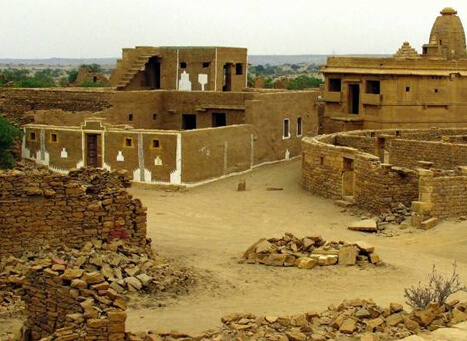
Once you visit the place, the sheer blankness of the village so massive, yet so eerily silent and abandoned with just the houses standing like skeletal corpses of the past engulfs you entirely. Adds to that the legend how the residents of the entire area left the place overnight altogether to save their honors and lives from the hands of the tyrannical minister who ruled over the place, and you have got the perfect setting for a bestselling horror story.
There is nothing to do as such, but the experience itself makes up for all of it. The government with the help of some private construction companies are setting up cafes, restaurants and even lodges for the night stay to turn the place into a full-fledged tourist place. The constructions are undergoing as of December 2017 and once finished, Rajasthan hopes to attract more people to visit and experience the great beauty amidst the barrenness.
Bada Bagh jaisalmer :- At a distance of 8 km from Jaisalmer Railway Station and 7 km from Jaisalmer Fort, Bada Bagh or Bara Bagh is a historical garden located on Ramgarh road and halfway between Jaisalmer and Lodurva in Rajasthan.
Bada Bagh means big garden. It is a garden of cenotaphs or chhatris of the royal family of Jaisalmer. A descendant of Maharawal Jaisal Singh, Jait Singh II, commissioned a dam to create a water tank in the 16th century AD. This made the desert green in this area. After his death, Bada Bagh was fully developed by his son Lunakaran.
The garden stands at the foot of a hill and several chhatris or cenotaphs stand in memory of the late rulers of Jaisalmer. Cenotaphs are also known as chhatris and one cenotaph is erected for each ruler. The cenotaph of Maharawal Jait Singh is the oldest of all. Many cenotaphs were built by subsequent rulers for the Bhatti royal family of Jaisalmer. This continued till the 20th century when the last one for Maharawal Jawahar Singh was left incomplete as his son who ascended the throne after him, died within one year of his ascension. This was considered to be bad luck and from then on, the tradition of cenotaphs at Bada Bagh was discontinued.
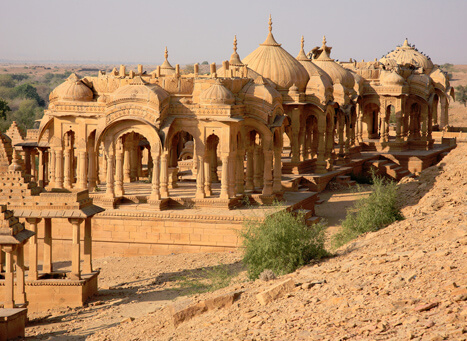
The architecture of these chhatris is a blend of Paliwal, Mughal, and Rajput styles of architecture. Each cenotaph contains inscribed tablets with names of the King and Queen. Some of the cenotaphs have a statue of the King on a horse along with his queen standing nearby. The size of the chhatri varies according to the status of the person.
This garden also includes a tank and a dam, along with a Govardhan Stambh (pillar). The pillar was constructed for commemorating the construction of the nearby tank and dam. Locals refer to the dam as Jait Bandh, while the tank is known as Jait Sar. The Jait Bandh is a huge structure measuring over 1,200 feet in length and 350 feet in width. Both the tank and dam has been constructed using solid blocks of stone.
Timings: 8 AM to 6 PM
Entry Fee: Rs. 20 for Indians and Rs. 50 for Foreigners
Gadisar lake Jaisalmer :- At a distance of 1.5 km from Jaisalmer Railway Station and 1.5 km from Jaisalmer Fort, Gadisar Lake or Gadsisar Lake is an artificial reservoir in Jaisalmer. It was the only source of water for the Jaisalmer city in the olden days and also one of the best Jaisalmer sightseeing places.
The Gadisar Lake was constructed by Raja Rawal Jaisal, the first ruler of Jaisalmer and later reconstructed by Maharawal Gadsi Singh in the year 1367 AD. It is said this rain water lake once provided water to the entire town. At present Gadisar Lake gets water from Indira Gandhi Canal so it never dries.
Located towards the south of Jaisalmer city, the entrance to the Gadisar Lake is through a magnificent and artistically carved yellow sandstone archway that is known as the Tilon-Ki-Pol. There are numerous shrines and small temples on the embankment of this lake. The most popular among these temples is the Krishna Temple which houses a statue of Lord Vishnu. There is a big domed pavilion in the center of the lake. The main attractions of the lake are the different species of birds, which migrate from distinct places.
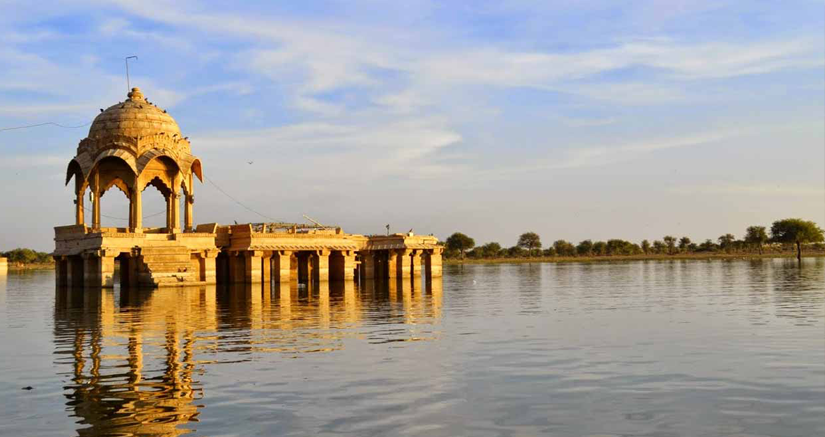
The Gadisar Lake can be visited any time of the day, though it is best to go early in the morning and watch the sun rise. Boating facility is also available in this lake where charges vary from type of boat and based on duration of boating. Shikaras are also available to go around the lake. The serene Gadisar Lake springs to life during the annual Gangaur celebrations. This is the most popular point to take photographs of Jaisalmer Fort early in the morning when the fort looks golden with the first rays of the Sun and also a bird viewing site and a major attraction of Jaisalmer city.
Timings: 6 AM to 6 PM
Sam Sand Dunes Jaisalmer :- At a distance of 40 km from Jaisalmer, Sam Sand Dunes are situated at the edge of Jaisalmer Desert National Park in Rajasthan. Lies in the midst of the Thar Desert, these sand dunes are amongst the most popular places to experience Rajasthan Tourism and also one of the prime places of Jaisalmer Tourism.
Sam has a truly magnificent stretch of sweeping dunes, with sparse or no vegetation. The 3 km long, and 1 km wide sand dunes reflect the true image of Rajasthan. Undeniably one of the most picturesque spots in the desert, the Sam Sand Dunes have gained tremendous tourist reputation over the time. The unrelieved ocean of sand constantly changes its appearance at every gentle gush of wind. The whirling air currents of this area match with those of the sandstorms in the Sahara. This time many Desert camp In sam sand dunes But Garh Rajputana camps is luxury Desert camp in Jaisalmer , Camp offer Camel Safari, there are many other Adventure activities like jeep safari, Paragliding, Quad Bike safari and desert camping at Sam Sand Dunes. Night stay with Swiss tents and mud cottages next to dunes. Adding to the magical charm of the atmosphere are the wonderful folk dance and music performance by the local artists. . . Tourists can be assured of enjoying the magic of dunes completely in the company of these guides. The dunes are best visited during the months between October and February when the heat is relatively less in the region. Evenings and night are the best times to visit the dunes because at this time the silver rays of moon spread its radiance in the entire region thereby making it glow like an ornament.

There is a Desert Festival organised in the month of February and is the best time to visit these dunes. This is a 3-day event showcasing the heritage and culture of Rajasthan. This extravaganza includes of a lot of events such as puppet shows, various competitions such as tug of war and Biggest Moustache, camel race, various folk performance and more. During this time, the desert comes alive with the sound and light show, dance and music.
Jaisalmer Tour Planner
Jaisalmer Attractions
Rajasthan Budget Tour Packages
Rajasthan Luxury Tour Packages













0 comments:
Post a Comment